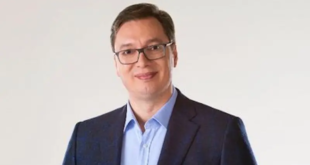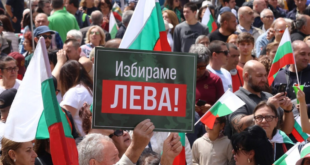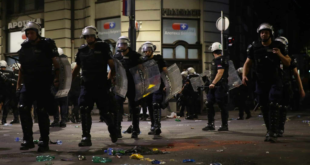 A sort of ‘two-party’ system will emerge from the December vote in Russia. But it won’t be even the docile two-party system envisioned under the Unified Russia-A Just Russia plan.
A sort of ‘two-party’ system will emerge from the December vote in Russia. But it won’t be even the docile two-party system envisioned under the Unified Russia-A Just Russia plan.
President Vladimir Putin’s surprise announcement this week that he will head the pro-Kremlin Unified Russia party’s list of candidates for the December 2 Duma elections sent shockwaves throughout the political system. Although the president has been closely associated with the party since it was created, he has — until now — rejected a direct correlation.
The most common interpretation of Putin’s move sees it as part of his presumed plan to remain personally in power after the March 2008 election. Tying his fortune to the party could, analysts note, open up for him opportunities to carve out powerful positions — that aren’t term limited — as prime minister, speaker of the Duma, or head of Unified Russia. With Putin leading the charge, the party will almost certainly get a solid constitutional majority in the new legislature, allowing it to pass any number of revisions to the law on government or even the constitution.
But pursuing this agenda also seems likely to scuttle the Putin administration’s efforts to develop at least the appearance of a two-party pluralist political system. The key to the half-hearted effort so far has been the creation and nurturing of the A Just Russia party, a left-leaning coalition led by long-time Putin ally and Federation Council Chairman Sergei Mironov. Although the sluggishness with which A Just Russia has developed since its founding in October 2006 suggests the Kremlin has never been entirely committed to the project, it has been touted as evidence that some in the administration would like to facilitate some sort of managed transition to a less authoritarian and more democratic system.
Before Putin’s decision, both Unified Russia and A Just Russia offered their complete endorsement of Putin, while simultaneously sparring with one another on issues such as corruption, natural-resources management, and wealth distribution. With Putin heading the Unified Russia list — in fact, Putin’s is the only name on the party’s national list — A Just Russia will find it impossible simultaneously to back Putin and oppose Unified Russia. The problem was symbolically revealed in Ryazan recently, when Unified Russia succeeded in removing billboards promoting A Just Russia with the slogan, “Putin’s Plan is the Victory of Justice” (“Putin’s Plan” is the name of Unified Russia’s campaign platform).
‘Complete Crisis Of Party System’
Because the party had been campaigning in this two-pronged way since its creation, Putin’s move definitely pulled the rug out from under it — as well as from the Liberal Democratic Party of Russia (LDPR), which also has backed Putin while attacking Unified Russia as a collection of bureaucrats and oligarchs. INDEM foundation President Georgy Satarov told “Vremya novostei” that Russia now faces “a complete crisis of the party system” because “all the parties that agreed to act like an opposition and play by the rules that the Kremlin proposed…have been placed in a situation that they — to say the least — did not expect.” “Therefore they have no room for a real public party contest,” Satarov concluded.
Mironov tried his best to put a brave face on Putin’s announcement, but his statements rang false. He told journalists on October 3 that Putin’s decision is a step toward “the formation of a real two-party system in our country” and claimed it would affect A Just Russia “positively.” “I think in the end we will get even more votes than we would otherwise,” Mironov said. RFE/RL’s Russian Service asked Moscow Carnegie Center analyst Andrei Ryabov about the statement: “It is very hard to agree with this assertion,” he said.
By all prognoses, Unified Russia was expected to receive 55-60 percent of the vote even before Putin’s bombshell. Levada Center analyst Aleksei Levinson has predicted the addition of Putin will boost that figure by 10-15 percent. But that estimate could turn out to be conservative, given Russia’s history and the way in which signals such as this one get transmitted down the power vertical to the regions. It should be noted that about 50 governors appear on Unified Russia’s regional lists and they will likely turn the vote into a simultaneous referendum on Putin and themselves. And there can be little doubt they will pull out all the stops to make sure the results of that referendum are as resounding as possible.
Pro-Moscow Chechen puppet president Ramzan Kadyrov reacted to Putin’s decision with an enthusiasm that will likely prove infectious. He predicted Unified Russia will now receive 95 percent of the vote in his republic (the party polled 79 percent there in December 2003, the highest in the country). He then immediately amended his prediction to say real support for Putin in the republic is “100 percent.” “I am just giving myself 5 percent as insurance,” Kadyrov said.
Chances Look Slim
Moreover, Putin’s move is likely to pull support from many other parties participating. Although Communist Party and LDPR officials were quick to say that only A Just Russia will suffer, their arguments seem unconvincing. Only the minor liberal parties the Union of Rightist Forces and Yabloko are, in the end, unlikely to see much of their tiny sliver of the vote defect. Pre-bombshell polling put the Communist Party at about 18 percent of the vote, meaning the party still has a clear chance of surmounting the 7 percent hurdle and picking up Duma seats. But the chances for the LDPR and A Just Russia, which were on the edge of the barrier before the announcement, now look very slim indeed.
Under Russian law, at least two parties must be represented in the Duma. Even if no party besides Unified Russia overcomes the 7-percent barrier, some seats will be allotted to the second-place finisher in any event. Russia will not see a result such as emerged in Kazakhstan in August, where the pro-presidential party transformed its domination of the system to complete domination of the legislature as well.
As a result, a sort of “two-party” system will emerge from the December vote in Russia. But it won’t be even the docile two-party system envisioned under the Unified Russia-A Just Russia plan. Instead, there will be a huge constitutional majority for Unified Russia and a token representation by the Communist Party. Although the Communist Party is a genuine opposition party (as opposed to A Just Russia’s facsimile), its support is fading from election to election and it is a safe bet the Kremlin will not allow the party to use its opposition platform in the Duma to generate real political influence or increase its public support. The Communist Party is, from the Kremlin’s point of view, a tolerable opposition both because it can be counted on to support the Kremlin in any issues touching the theme of Russia as a great power and because no other opposition parties are ever going to be willing to form a coalition with it.
By the time of the next election, there is a good chance even the Communists will be so weakened that they will be unable to garner the 7 percent needed to earn seats. If that scenario emerges, the two-party system in Russia will depend on the artificial life support of the law ensuring at least two parties in the legislature. And analysts will need a magnifying glass to tell the difference between Russia and neighbors like Kazakhstan, Uzbekistan, and Turkmenistan.
Source:Â Energy Publisher
 Eurasia Press & News
Eurasia Press & News



